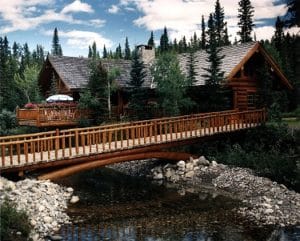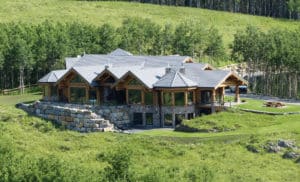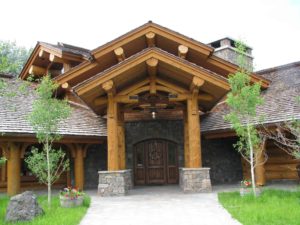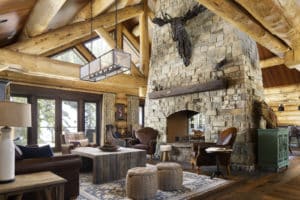
Menu

If you are like most people who are considering purchasing a log home, it may very well be one of your most important personal environmental and financial decisions you will make.
I would like to offer you my experiences and some of the most important benefits to building a Moose Mountain Log Home. My name is Lloyd Beckedorf and I have been building full-scribe handcrafted log homes as my sole profession since 1978 (link for: the different types of log home construction comparison).
Many people trace their desire to live in a log home to something that sparked an emotional feeling of well-being. It may be your childhood memories of a summer cabin or stories from friends or relatives of their experiences. It could also be more recent, such as being in a well-built log home during a winter storm, or perhaps photos in a log home magazine which made you realize how impersonal and lifeless conventional housing has become. No matter where your desire originated, the decision to build a log home will be an extremely important and personal one. Less than five percent of the people Moose Mountain has built their dream home for, have ever sold their home. The people we have helped create their ideal place to live in, have done so because that is where they truly wish to remain for a long time.

When people build a log home to live in for a long time, craftsmanship, design, quality of logs plus other materials, and comfort against winter’s cold and summer’s heat become paramount in a formula of value for your investment. When you choose a Moose Mountain Log Home it does mean that one of your highest concerns is the quality of your environment, in determining value for your housing needs. Sadly, from what I have seen, there are many ways to reduce the initial cost of a log home by reducing the quality of the craftsmanship or in the logs needed to produce that log home, but ultimately it will always result in a wish that you hadn’t cut corners on what you thought was a less expensive quote which usually ends up costing more in the end. Our approach though, has been one of paying close attention to the countless little aspects of producing a true work of art and function that some of which in themselves may not seem that important, however together produce significant advantages and allow us to state unequivocally, there is no better built home than a Moose Mountain log home.
If you consider that a log home, from the standpoint of the log construction, is comprised of a balance of design, joinery techniques, log quality and beauty, craftsmanship plus attention to countless little details and other construction materials, as well as affordability, then, I am sure you agree, it becomes important that you evaluate your objectives in building a log home in each of these categories.
 DESIGN
DESIGN
I feel it is important that the design reflects your present living requirements plus your perceived future demands. The draftsman/designer/architect should have previous log experience and blend your building site’s advantages of view, slope, access, vegetation cover and sunlight directions with your space requirements, together with the log builder’s experience and understanding. I have never seen a previously used plan suit the needs perfectly for other people at another location. I believe if you develop a scrap book approach of things you like and dislike, and keep your site in mind, you will be amazed how easy it will become to develop your plan. Make sure that your person in charge of the plan listens carefully to you and the log builder. Of the many renowned architects/designers we have worked with we have one we can strongly recommend because of the years of mutual co-operation and great projects we have created together, our designer/draftsman, Gordon Snell of Innographic Design and Drafting, who has worked with us for over 30 years is extremely talented. Another renowned designer that we have had the pleasure of working with is Murray Arnott. They have both consistently demonstrated a real flair for creating something entirely original, suited to those who will live there, within the scope of structural function and cost effectiveness. It will be important that your log builder draw on a wide variety of experience and have a real zest for creating something unique in guiding the person you designate to develop your plans.
It is also important to remember that the working drawings, the ones you will hand in for permit approval, will most significantly draw on the previous log experience of the person in charge of your plans. We highly suggest you take extra time in researching the previous experience of the individual or firm you choose.
JOINERY TECHNIQUES
Here is where you will find the greatest differences in buildings and quality, and this requires the most research by you, the log home purchaser. To build the most air and weather-tight home, the most comfortable home in the winter’s cold and summer’s heat, specifically means you have to develop a seal that works with wood and its continuous attempt to equalize its moisture content with the air relative humidity.
If it were only as simple as initially fitting logs together tightly, that would be the only measure of quality joinery, then every first year log builder would be an expert. It is when you compare techniques after several years of performance in a home, that quality of joinery becomes glaringly obvious to even the slightest of educated eyes. Most companies produce a product that, at delivery, gives no indication of what its future appearance and performance will be like. I have written several articles on our methods of joinery (link for: Techniques that make Moose Mountain Different) which goes into more of the technical detail, I hope you have a chance to study these and that you ask me any questions which may develop. It is in full-scribe joinery where craftsmanship and skill are vital as opposed to the chinked style log home where chinking alone replaces the need for precision and craftsmanship. Here in full-scribe joinery, through experience and interaction with the builders and the buildings built of the more common Swedish Cope or Scandinavian Shallow Cove, is where the differences of our patented Double-Scribe Lateral Groove and our Shrink-Fit Saddle Notch allow us to claim there is no better method of log joinery.
When you take the time to understand how wood reacts to joinery and changes in moisture, you will understand it is absolutely impossible for any of the Scandinavian or Swedish Full-Scribe Cope or Cove methods to produce a product which will perform as well as our Double-Scribe Lateral Groove and Shrink-Fit Saddle Notch joinery.
LOGS
When choosing the species of log which will give you optimum results, two factors are critical to keep in mind – checking – which are the longitudinal splits that occur during drying and how deeply the species will take a finish such as a protective stain or oil. Checking, if crossing joinery, will allow air and weather leaks and also insects to pass from outside to inside. Excessive checking will extend beyond the penetration of a protective stain or oil and likely allow moisture from driven weather to accumulate and cause wood deterioration. Uncontrolled checking tends to localize in the Cove or Cope style of full-scribe joinery, allowing for pronounced visual gaps and leaks. For the reasons of checking and resulting leaks, I would never consider using checked dead standing timber in a log home. Logs which are already randomly riddled with uncontrolled checks would be almost 100% guaranteed to create a drafty, insect infiltrated home unless every single check is caulked or chinked, something that, from experience, I have seen is virtually impossible to do. It is my firm opinion, that if chinking or caulking is required it is an absolute and unacceptable failure of the joinery and/or log selection.
Our patented method of joinery, undeniably is by far the very best method of keeping logs tight fitting and controlling checking to such a degree, that we are still the only “handcrafted company” to have patented joinery, guaranteed against air and weather leaks and with a 100% perfect track record that has never required chinking or caulking. This is almost entirely attributable to our highly specialized joinery which we began using in 1985, in combination with our log selection process.
The depth of penetration and thereby adhesion of a protective finish is really the most important factor in choosing a species of tree by the degree of maintenance it will require in the years to come. If one considers that a power or telephone pole is subjected to the harshest factors a log in a log home could ever be exposed to, then only Pine and Cedar excel as proper choices for log wall construction. To date, Spruce has never been considered for pole uses because of its lack of ability to absorb treatment, as well Fir and Larch have a very limited use due to the minimal treatment penetration and excessive twisting and warping characteristics in dryer climates.
When you consider checking or the long term maintenance of a log home to use Fir, Larch or Spruce in log wall construction is, in my opinion, a poor choice or lacking experience on behalf of the log builder. However, to use the structural characteristics of Fir, Larch or Spruce under the immediate protection of a roof or within the enclosure of a home as a beam or a joist, has a definite merit. To achieve the optimum results in a log home, without a doubt, only Pine or Cedar should be used as a wall log. Choosing between Pine or Cedar should mainly be based on the climate your home will be in. Cedar as a log lives up to its reputation as having heartwood capable of sustained exposure to wet weather with the minimum of detrimental effects. The size and hues in Cedar allow us to achieve the “Classic Lodge” stature and feel. The low initial moisture content and stable nature have long been known as a significant advantage to using Cedar. Perhaps the only downside would be the softness of the wood and its ability to be more easily marked by handling.
With Lodgepole Pine we can accentuate the numerous unique characteristics found in individual trees. With a transparent, protective stain, few woods have the lustre and beauty that is so engrained as in the Lodgepole Pine. A significant advantage Lodgepole Pine has over all other Pines, Fir, Larch and the Spruces is that these other species are between twenty and eighty-five percent more susceptible to checking. In fact, few woods are more easily controlled against checking or can absorb a transparent protective stain as deeply. The way Lodgepole Pine shrinks is what makes it so incredibly ideal for log wall use. The drier the climate the more significant this benefit becomes. It is the tangential to radial shrinkage ratio (or the way it shrinks in circumference compared to the way it shrinks in diameter) that is so extremely important, that relationship allows Lodgepole Pine to be one of the most controllable against checking of any soft wood species used in log construction today. (Remember this does not apply to dead standing or pre-dried Lodgepole Pine logs. where the checks are already present). That ratio defines a species susceptibility to most forms of warp and of course checking during the course of seasoning. Simply put in drier climates, species prone to excessive checking such as Eastern White Pine, Fir, Larch or the Spruces when used as wall logs would not be able to be warranted with our air and weather tight guarantee!
For further great information on this topic check out R. Bruce Hoadley’s “Understanding Wood, A Craftsman’s Guide to Wood Technology” considered by many experts to be the best written material for the lay person.
CRAFTSMANSHIP.
Craftsmanship is implementing the design with flair, precision and experience. A joy which is characteristic of true craftsmanship is the pride experienced in sharing the precision in a meticulously crafted log-trussed roof system or log staircase, or in choosing of the right log for that special location in a flawlessly notched and fitted wall – and knowing from experience that is the best that can be done. Craftsmanship is taking the extra time to make something just a little bit better or more special. Craftsmanship is one of the most talked about aspects of log construction, yet one of the most abstract, least definable and important values of log construction.
 ATTENTION TO LITTLE DETAILS AND OTHER CONSTRUCTION MATERIALS
ATTENTION TO LITTLE DETAILS AND OTHER CONSTRUCTION MATERIALS
Often the most visual differences in a log home began as a little detail which was either overlooked or carefully thought out. One such common detail would be to allow water a place to accumulate and not quickly drain away from a log wall, and that may not become apparent until staining or deterioration are noticed years later. Other details such as through-bolts, their location and future operation, or screw jack visibility and performance, or our time-tested and much refined window details with our supplied structural keyways, or joinery gasket use, are just a few of the details that few other builders can compare with. Then, when you look at our frame partition wall to log wall joint, or the completeness of our electrical channeling and switch or receptacle box detailing, and the total carpenter readiness which we provide as our standard package, we know you will begin to realize that undoubtedly, if there is a lower priced competitor, it is by what they omit to include or the corners they cut in the quality of the logs and joinery they use that will by far, cost more in the future.

We profoundly believe that, when you compare every last detail, our superior logs and log selection process, and our unequaled joinery and craftsmanship, that you simply won’t be able to find a better value for your investment, or a better built home than a Moose Mountain log home. However, it won’t be until during a winter storm when you sit and gaze into a fireplace or lean back and look up at the sturdy gracefulness of a log open beam cathedral ceiling that you will fully grasp how important your decisions today may really have been to you and generations to come that will reside in your log home.
#46 Griffin Industrial Point
Cochrane, AB
T4C 0A3